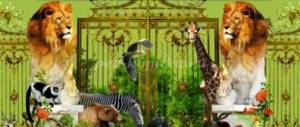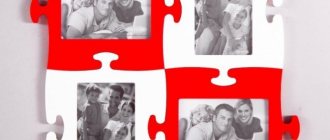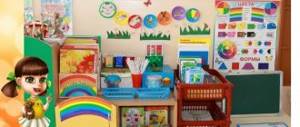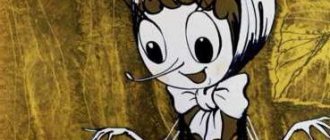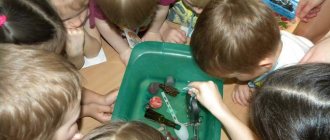Cognitive activity as a child’s initiative activity
The importance of this function is actively promoted and popularized, but young mothers do not always understand what lies behind the complex psychological term.
To understand what the cognitive activity of preschoolers is, it is enough to observe the child and his actions.
An urgent desire to understand the world around, endless questions, clarifications mean normal curiosity and activity. The key feature of the concept is the child’s initiative. It is he who initiates the exploration of objects and conversation. Encourages you to independently search for answers and try to check what happens if you give a cat a bath in the bathtub, or put a chair on the sofa and climb on it...
These functions become possible with the skills of analysis and synthesis. Observing this or that action, the preschooler intuitively analyzes the components, and then tries to apply the sequence in other conditions. A striking example is that same swimming cat or the keen interest in the anatomy of insects or dolls.
There are several levels of cognitive activity. Primary diagnosis of the severity of interest and curiosity can be carried out on the basis of manifestations of children's self-organization:
- The weakness of the latter is evidenced by the refusal to repeat attempts to make a Easter cake or draw a house after the first failure;
- High self-organization ensures a persistent desire to achieve success and cope with the difficulties that arise.
Middle group
By the age of four, a child’s perception changes; this is due to changes in the structure of the brain, improvement of mental processes, mastery of speech and the acquisition of experience. Cognitive activity changes: the child is now able to perceive and assimilate verbal information, and not just subject information. To consolidate this skill, you need to act in stages:
- The child is given verbal information about some object or phenomenon.
- This phenomenon or this object is shown by demonstrating certain functions or qualities. The story is repeated aloud to consolidate knowledge.
Kinesiological gymnastics for preschool children
In this way, children connect words and the material world. What parents should pay attention to when shaping the cognitive activity of a preschooler at this age:
- New information must be understandable to the child and based on those images of the external world that have already been formed.
- First of all, the baby is introduced to objects and phenomena in the immediate circle of his life.
- This should be positive information that is familiar to the adult who is delivering it.
Preschoolers of this age are taught sequences of actions and develop their work skills. Children learn the external parameters of materials - fabric, glass, paper, make models and collages.
Engines of children's cognitive activity
Experts in the field of developmental psychology identify 3 main engines of cognitive activity. They are interconnected, start in the first years of life and help a preschooler understand the structure of the universe. Their natural purpose is to stimulate the cognitive activity and interest of preschoolers, and then students.
Interest
Curiosity and interest are the basis of cognitive activity. These qualities form the need to recognize the unknown and explore the novelty of the subject. This drive is especially pronounced in younger preschoolers - at 3-4 years old.
The first signs: constant questions on the most unexpected topics. Sometimes, areas of interest baffle parents and educators, but this phase is the most important. Ignoring a child’s interest will most likely lead to a loss of curiosity and a decline in cognitive activity.
The main task of adults at this stage is not only to answer questions, but also to encourage the child to ask new ones, to educate and instill the need to constantly understand unfamiliar information.
Independence
Independence is manifested in children with an advanced level of development. They are not limited to carrying out the tasks of their elders. Being ahead of their peers, preschoolers retain their ability to work, which encourages additional activities:
- Receiving new tasks, especially creative ones;
- Commenting on your own actions;
- Repeating the work if the result is unsuccessful.
Observation
A child's observation ability is closely related to perception. This function develops attention, imagination, and the ability to remember little things. At 3-4 years old, the child does not yet know how to deliberately study this or that subject.
His attention is drawn to what seems interesting: falling snowflakes, heavy rain, splashing puddles, bright clothes on a doll or a person. Therefore, gaming activities are used to develop observation skills. If there are objects that attract a baby, he will notice exactly what seems most important to him: the unusual shape of a toy, the special taste of a wooden cube, the orange color of an orange.
Initially noticed signs are inseparable from the object. Only later will the child learn to separate the property from the object. For example, splashes of water on the street may be because dad is watering the garden with a hose, and the cube does not necessarily have a taste, and in general is not an edible item.
Collection of diagnostic methods for cognitive development of preschool children
Yulia Baboshina
Collection of diagnostic methods for cognitive development of preschool children
Section 1 Diagnostic methods for studying the cognitive motivation of a preschooler .
1.1 “Magic House” technique
1.2 Methodology “Questioner”
(
Methodology of M. B. Shumakova.) Purpose: Studying the cognitive activity of a preschool child , the ability to ask questions.
Diagnostic indicators : curiosity, interests, cognitive need , cognitive interest .
Age range : senior preschool age .
Source of information: children
Form and conditions: individual
Instructions: Preparation and conduct of the study. Pick two pictures. One should be close to children in content (this could be children playing, winter activities, etc. ), the other should depict objects unfamiliar to him.
Invite your child to play the game "Question"
.
Tell him that he can ask anything he wants to know about the objects shown in the pictures. In the minutes, record the names, gender, age and questions of each child.
Data processing and interpretation. The received materials are processed according to the following criteria:
– breadth of coverage of objects depicted in the pictures;
– the number of questions asked by one child;
– type of questions.
1st type. Establishing questions are questions aimed at highlighting and identifying the object of study ( “Who is this?”
,
“What are the books on?”
).
2nd type. Definitive questions - related to the identification of various signs and properties of objects, the determination of temporal and spatial characteristics ( “Does a camel like bread?”
,
“What is the hat made of?”
,
“Is the water cold?”
).
3rd type. Causal questions – related to the knowledge of the relationship of objects, identifying causes, patterns, the essence of phenomena ( “Why is the boy gloomy?”
,
“Why does a girl need a bag?”
,
“Are they frozen?”
).
4th type. Hypothesis questions expressing assumptions ( "The boy doesn't go to school because he hasn't done his homework?"
,
“Is the girl crying because she is lost?”
).
10 points – the child asked 4 or more questions of all types; 8-9 points the child asked 3 – 4 questions of all types; 4 – 7 points the child asks 2 to 3 questions; 2 – 3 points the child asks 1 question; 0 – 1 point the child was unable to ask a single question.
Converting points to level:
10 points – very high level; 8 – 9 points – high level; 4 – 7 points – average level; 2 – 3 points – low level; 0 – 1 point – very low level.
They draw conclusions about the level of cognitive activity of individual children and their ability to ask questions. Children who do not know how to ask questions are given special attention in the future
Game "Question"
can be used to teach
children the ability to ask questions.
1.3 Methodology “Selection of subject-thematic pictures” (N.V. Prophet)
.
Goal: Identifying the direction of children's .
Diagnostic indicators : curiosity, interests, cognitive need , cognitive interest .
Age range : senior preschool age .
Source of information: children
Form and conditions: individual
Instructions: A set of 28 subject-themed pictures - 7 series on four different subjects related to 4 types of activities: gaming, educational, creative, labor. Separate sets with characters of the corresponding gender are being prepared for boys and girls.
Procedure: It is proposed to select several cards (at least 7)
from those laid out on the table. After choosing, the child is asked why he chose these pictures.
Data processing: Assessment of the focus of interests is carried out on the basis of 2 parameters: preferred types of activities; justification for choice.
If a child makes 4 or more choices on one topic, it is considered that his motives for this activity dominate.
Section 2. Diagnostic methods for studying the cognitive actions of preschool children .
2.1 Methodology “What objects are hidden in the drawings?”
(Nemov R.S.)
Purpose: Diagnosis of cognitive abilities .
Diagnostic indicators : Cognitive actions .
Age range:
Source of information: children
Form and conditions: individual
Instructions: The child is explained that he will be shown several contour drawings in which, as it were, “hidden”
many objects known to him.
Next, the child is presented with rice. (Appendix No. 1)
and are asked to consistently name the outlines of all
objects “ hidden”
in its three parts: 1, 2 and 3.
The task completion time is limited to one minute. If during this time the child has not been able to completely complete the task, then he is interrupted. If the child completed the task in less than 1 minute, then the time spent on completing the task is recorded.
Note. If the person conducting the psychodiagnostics sees that the child begins to rush and prematurely, without finding all the objects , moves from one drawing to another, then he must stop the child and ask him to look in the previous drawing. You can move on to the next picture only when all the objects in the previous picture have been found. The total number of all items " hidden"
in Figures 1, 2 and 3, is 14.
Data processing:
10 points - the child named all 14 objects , the outlines of which are in all three drawings, spending less than 20 seconds on this.
8 – 9 points – the child named all 14 objects , spending 21 to 30 seconds searching for them.
6 – 7 points – the child found and named all the objects in a time from 31 to 40 seconds.
4 – 5 points – the child solved the problem of finding all the objects in a time from 41 to 50 seconds.
2 – 3 points – the child coped with the task of finding all the objects in a time from 51 to 60 seconds.
0 – 1 point – in more than 60 seconds, the child was unable to solve the problem of finding and naming all 14 “ hidden” objects
in three parts of the picture.
Conclusion about the level of development :
10 points – very high level, 8 – 9 points – high level, 4 – 7 points – average level, 2 – 3 points – low, 0 – 1 point – very low.
2.2. Methodology “Learn words”
(Nemov R. S.)
Purpose: Diagnosis of perception in preschool children .
Diagnostic indicators : Cognitive actions .
Age range:
Source of information: children
Form and conditions: individual
Instructions: Using this technique, the dynamics of the learning process are determined. The child receives a task in several attempts to learn by heart and accurately reproduce a series consisting of 12 words: tree, doll, fork, flower, telephone, glass, bird, coat, light bulb, picture, man, book.
Memorizing a series is done like this. After each listening session, the child tries to reproduce the entire series. The experimenter notes the number of words that the child remembered and named correctly during this attempt, and reads out the same series again. And so on six times in a row until the results of playing the series in six attempts are obtained.
The results of learning a series of words are presented on a graph, where the horizontal line shows the child’s successive attempts to reproduce the series, and the vertical line shows the number of words he correctly reproduced in each attempt.
Evaluation of results
10 points - the child remembered and accurately reproduced all 12 words in 6 or fewer attempts. 8-9 points - the child remembered and accurately reproduced 10-11 words in 6 attempts. 6-7 points - the child remembered and accurately reproduced 8-9 words in 6 attempts. 4-5 points - the child remembered and accurately reproduced 6-7 words in 6 attempts. 2-3 points - the child remembered and accurately reproduced 4-5 words in 6 attempts. 0-1 point - the child remembered and accurately reproduced no more than 3 words in 6 attempts.
Conclusions about the level of development : 10 points - very high; 8-9 points - high; 4-7 points - average; 2-3 points - low; 0-1 point - very low.
2.3 Methodology “What’s superfluous here?”
Purpose: this technique is intended for children to explore the processes of figurative and logical thinking, mental operations of analysis and generalization in a child.
Diagnostic indicators : diagnostics of cognitive actions .
Age Range : 4 – 5 years
Source of information: children
Form and conditions: individual
Instructions: in the method , children are presented with a series of pictures showing different objects:
“In each of these pictures, one of the four objects depicted in it is extra . Look carefully at the pictures and determine which item is superfluous and why.”
3 minutes are allotted to solve the problem.
Evaluation of results
10 points - the child solved the task assigned to him in less than 1 minute, naming the extra objects in all the pictures and correctly explaining why they are extra.
8-9 points - the child correctly solved the problem in a time of 1 minute. up to 1.5 min.
6-7 points - the child completed the task in 1.5 to 2.0 minutes
4-5 points - the child solved the problem in a time of 2.0 to 2.5 minutes.
2-3 points - the child solved the problem in a time from 2.5 minutes to 3 minutes.
0-1 point - the child did not complete the task in 3 minutes.
Conclusions about the level of development
10 points – very high. 8-9 points - high. 4-7 points - average. 2-3 points - low. 0-1 point - very low.
2.4 Methodology “Cut Pictures”
(S. Zabramnaya)
Purpose: to identify the level of development of visual and effective thinking.
Diagnostic indicators : diagnostics of cognitive actions .
Age Range : 3 – 4 years
Source of information: children
Form and conditions: individual
Instructions: the child is offered a series of pictures divided into several parts. The child is asked to make pictures.
Evaluation of results:
3 points: the child completed the task independently and completed it without errors.
2 points: the child completed the task with minor errors, with a little help from the teacher.
1 point: the child experienced significant difficulties in completing the task, he needed the help of a teacher.
2.5 Methodology “Triangles-2”
(E. Dodonova)
Purpose: identifying the level of development of voluntary attention and voluntary memory.
Diagnostic indicators : cognitive actions
Age range : 5 – 6 years
Source of information: children
Form and conditions: individual, group
Description: the child is asked to draw a certain number of triangles in a row, some of them must be shaded with the color specified by the adult. Repeating the task is strictly prohibited. If the child doesn’t remember, let him do it his own way.
Equipment: a box of colored pencils, a sheet of paper, a protocol for recording the results.
Instructions: “Now we will play. Be careful. I will explain the task only once. Draw ten triangles in a row. Shade the third, seventh and ninth triangles with a red pencil.”
Fixed parameters: the number of errors when executing the task.
Standards: high level - the task was completed correctly; medium level - draws a specified number of figures in a row, but does not stroke in the order required by the instructions; low level - the number of shapes and the order of shading does not correspond to the instructions.
Section 3. Diagnostic methods for studying the imagination and creative activity of preschool children .
3.1 Method “Come up with a story”
(Nemov R.S.)
Purpose: Determine the level of imagination of the subject.
Diagnostic indicators : Imagination, creative activity
Age range : 5 – 6 years.
Source of information: children
Form and conditions: individual
3.2 “Nonsense”
technique (Nemov R.S.)
Purpose: With the help of this technique , the child’s elementary figurative ideas about the world around him and about the logical connections and relationships that exist between some objects of this world: animals, their way of life, nature are assessed. Using the same technique, the child’s ability to reason logically and express his thoughts grammatically correctly is determined.
Diagnostic indicators : Awareness
Age range : 3 – 4 years.
Source of information: children
Form and conditions: individual
Instructions: First, the child is shown a picture. (Appendix No.)
. It contains several rather ridiculous situations with animals. While looking at the picture, the child receives instructions approximately as follows:
“Look carefully at this picture and tell me if everything here is in its place and drawn correctly. If something seems wrong to you, out of place or drawn incorrectly, then point it out and explain why it is not so. Next you will have to say how it really should be.”
Note. Both parts of the instruction are executed sequentially. First, the child simply names all the absurdities and points them out in the picture, and then explains how it really should be. The time for exposing the picture and completing the task is limited to three minutes. During this time, the child should notice as many absurd situations as possible and explain what is wrong, why it is not so and how it really should be.
Evaluation of results:
10 points - this score is given to the child if, within the allotted time, 3 minutes. He noticed all seven absurdities in the picture, managed to satisfactorily explain what was wrong, and, moreover, say how it really should be.
8 - 9 points - the child noticed and noted all the existing absurdities, but from one to three of them was not able to fully explain or say how it really should be.
6 - 7 points - the child noticed and noted all the existing absurdities, but three or four of them did not have time to fully explain and say how it really should be.
4 - 5 points - the child noticed all the existing absurdities, but 5 - 7 of them did not have time to fully explain and say how it really should be in the allotted time.
2 - 3 points - in the allotted time the child did not have time to notice 1 - 4 of the 7 existing absurdities, and it did not come to an explanation.
0 – 1 point – in the allotted time the child managed to discover less than 4 out of 7 available absurdities.
Comment. A child can receive a score of 4 or higher in this task only if, within the allotted time, he has completely completed the first part of the task, defined by the instructions, i.e., he discovered all 7 absurdities in the picture, but did not have time to either name them, or explain how it really should be.
Conclusion about the level of development :
10 points – very high, 8 – 9 points – high, 4 – 7 points – average, 2 – 3 points – low, 0 – 1 point – very low.
3.3 Method “Draw something”
(Nemov R.S.)
Purpose: Determine the level of imagination of the subject.
Diagnostic indicators : Imagination, creative activity
Age range : 5 – 6 years
Source of information: children
Form and conditions: individual
Instructions: The child is given a sheet of paper, a set of felt-tip pens and is asked to come up with and draw something unusual. You have 4 minutes to complete the task. Next, the quality of the drawing is assessed according to the criteria given below, and based on this assessment, a conclusion is drawn about the characteristics of the child’s imagination.
The child’s drawing is assessed in points according to the following criteria:
10 points - the child, within the allotted time, came up with and drew something original, unusual, clearly indicating an extraordinary imagination, a rich imagination. The drawing makes a great impression on the viewer; its images and details are carefully worked out.
8-9 points - the child came up with and drew something quite original, imaginative, emotional and colorful, although the image is not completely new. The details of the picture are worked out well.
5-7 points - the child came up with and drew something that, in general, is not new, but carries obvious elements of creative imagination and leaves a certain emotional impression on the viewer. The details and images of the drawing are worked out moderately.
3-4 points - the child drew something very simple, unoriginal, and the drawing shows little imagination and the details are not very well worked out.
0-2 points - in the allotted time, the child was unable to come up with anything and drew only individual strokes and lines.
Conclusions about the level of development :
10 points - very high, 8-9 points - high, 5-7 points - average.
3-4 points - low, 0-2 points - very low.
3.4 Diagnostic projective technique “Wish Tree”
(BC Yurkevich)
.
Purpose: Studying the cognitive activity of children (pictures and verbal situations are used)
.
Diagnostic indicators : Imagination, creative activity
Age range : 5 – 6 years
Source of information: children
Form and conditions: individual
4.1 Method “Seasons”
.
(Nemov R.S.)
Goal: Awareness of oneself and the world.
Diagnostic indicator : the formation of primary ideas about oneself, other people, objects in the surrounding world, about the properties and relationships of objects in the surrounding world.
Age range : 3 – 4 years.
Source of information: children.
Form and conditions: individual.
Instructions: This technique is intended for children aged 3 to 4 years . The child is shown a drawing and asked, after carefully looking at this drawing, to say what season is depicted in each part of this drawing. The time allotted to complete this task is 2 minutes. – the child will have to not only name the corresponding time of year, but also justify his opinion about it, that is, explain why he thinks so, indicate those signs that, in his opinion, indicate that this part of the picture is shown it is this, and not any other time of the year.
Evaluation of results:
10 points - within the allotted time, the child correctly named and associated all the pictures with the seasons, indicating on each of them at least two signs indicating that the picture depicts this particular season (in total, at least 8 signs for all pictures)
.
8-9 points - the child correctly named and associated all the pictures with the right seasons, while indicating 5-7 signs confirming his opinion in all the pictures taken together.
6-7 points - the child correctly identified the seasons in all the pictures, but indicated only 3-4 signs confirming his opinion.
4-5 points - the child correctly identified the time of year in only one or two pictures out of four and indicated only 1-2 signs to support his opinion.
0-3 points - the child was unable to correctly identify any season and did not accurately name a single sign (a different number of points, from 0 to 3, is given depending on whether the child tried or did not try to do this).
Conclusions about the level of development : 10 points - very high, 8-9 points - high, 6-7 points - average, 4-5 points - low, 0-3 points - very low.
4.2 Methodology conversation “Tell about yourself” (A. M. Shchetinina)
Purpose: to study the level and nature of assessment, the formation of the “I” image, the degree of awareness of one’s characteristics.
Diagnostic indicators : formation of primary ideas about oneself.
Age range : 5 – 6 years.
Form and conditions: individual.
4.3 “Name the words” technique
.
(Nemov R.S.)
Purpose: The technique determines the vocabulary that is in the child’s active memory.
Diagnostic indicator : the formation of primary ideas about objects in the surrounding world, about the properties and relationships of objects in the surrounding world.
Age range : 5 – 6 years.
Source of information: children.
Form and conditions: individual.
4.4 Method “Who eats what?”
(4-5 years)
Goal: to identify the level of development of visual-figurative thinking, to identify the stock and accuracy of ideas.
Diagnostic indicators : Imagination, creative activity
Age Range : 4-5 years
Source of information: children
Form and conditions: individual.
Instructions: Place pictures in front of the child that depict animals and the food they eat.
The child must name the animal and say what this animal eats, and select the corresponding pictures.
Evaluation of results:
3 points: this rating is given if the child completed the task without errors. He independently named all the animals and the food they eat.
2 points: this assessment is given to the child if the child has completed the task, the help of the teacher is insignificant.
1 point: the child lays out the cards at random.
4.5 “Pick a Pair” technique (5-6 years)
Goal: to identify the stock and accuracy of ideas, to identify the ability to establish connections between objects.
Diagnostic indicators : Imagination, creative activity
Age range : 5 – 6 years
Source of information: children
Form and conditions: individual.
Instructions: the child is given two rows of pictures depicting objects . Ask your child to match the items shown in the left row to the ones that match those in the right row and explain his choice.
Evaluation of results:
3 points: this rating is given to a child if the child completed the task without errors and was able to justify his choice.
2 points: this assessment is given to a child if the child completed the task, made 1-2 mistakes, and in 1-2 cases was unable to explain his choice
1 point: the child completed the task with the help of the teacher.
How does cognitive activity manifest itself in early preschool age?
According to developmental psychologists, the cognitive activity of a preschooler manifests itself in the form of the following signs:
- Expressed interest in a particular phenomenon or subject;
- The presence of not just interest in the subject, but a pronounced emotional coloring - amazement, grief, joy, surprise;
- Passion for history, fairy tales or games;
- A clearly demonstrated desire to complete tasks given by adults;
- Showing independence in choosing a game or activity.
Having identified children's interest in the world around them, it is important to use ways to stimulate activity. This will allow you to consolidate existing results and develop new skills that will later help your child successfully study at school.
Further stimulation of interest in knowledge is provided by:
- Creating various thematic “corners” that provide the child with the opportunity to independently choose activities and games;
- Regular games conducted by parents or educators, aimed at developing communication, cognition, solving problems of a certain complexity - folding cubes, pictures from several parts;
- Providing independence so that the child learns to complete tasks without outside help.
Techniques and technologies for cognitive development in kindergarten
The following methods and technologies of cognitive development are used:
- Project activity method. Develops research interest and thinking of a preschooler.
- Experimental research method. Develops activity and independence, the child learns to observe, think, compare, answer questions, draw conclusions, establish a cause-and-effect relationship, and follow safety rules. This includes conversations, observations, modeling, and conducting experiments.
- TRIZ pedagogy. This includes the formation of logical thinking in the child and the development of creative initiative.
- The "magic track" method. The following are set on it: color, shape, size, material, etc., depending on the purpose of the lesson. The hero wanders along this path, transforming in an amazing way.
- The Magic TV method. Consideration of objects and its parts, its connections with the environment.
What educational areas in preschool educational institutions are provided for by the Federal State Educational Standard for Preschool Education?
Methods are visual, practical and verbal.
Development of cognitive activity in children of middle and senior preschool age
During the period of 5-6 years, a child strives to independently find answers to questions about the structure of living or inanimate nature. The ability to see original images in ordinary objects and phenomena is becoming more and more evident, and cognitive abilities are developing.
The task of an adult is to support the development of cognitive activity of preschool children and create conditions for them to independently cope with problematic search situations and find answers to their endless “how” and “why”.
If an adult supports the child’s curiosity, then he will not simply passively complete the task, but will try to penetrate beyond the boundaries of the task. For example, coloring a picture transforms into attempts to come up with a story about what happened before and after the moment captured on paper.
Experimentation
After reaching five years of age, the development of cognitive activity of preschoolers is built in stages. Each phase becomes the basis for the next. The first stage is experimentation. The main features of this phase:
- Refusal of the usual way of solving a problem;
- Attempts to find a new innovative method to achieve the goal.
Often the experimentation stage is triggered by existing creative experience and proven ways to achieve results.
In the process of experimentation, it is very important not only to study the subject, but also to learn to record the results so that a useful activity does not turn into ordinary self-indulgence. Examples of experimentation in preschoolers: converting ice into water, dissolving soap and blowing bubbles, forming foam from shampoo.
Mandatory conditions for experimentation:
- Formation of a “hypothesis”, that is, interest in what will happen as a result of the experiment;
- Sequence of actions independently identified by children;
- Commenting by the child himself on each manipulation;
- Answers to the questions: what happened and why?
- Discussion: what new did the child learn, what caused confusion, what questions remained?
An additional benefit from the exploratory nature of this method of development is the opportunity to make the child feel like an adult, a scientist, a discoverer.
Collecting
Collecting is one of the most powerful incentives for the development of a preschooler’s cognition. The process itself involves the collection of certain objects and objects, united by a sign or criterion. Collectible items may include:
- toys made from sweets;
- figurines of various types;
- thematic pictures;
- mineral stones;
- buttons of unexpected shapes and sizes;
- calendars;
- magnets.
First of all, the creation of personal collections causes a competitive effect, which encourages the child to find new ways to replenish their own collections and determine whether a new item corresponds to the stated topic.
Preschoolers manage their collections productively, showing business cooperation in communicating with peers. They exchange copies of equal value, or may offer the entire set in exchange for a toy or other item of value to them. By mastering the ability to negotiate and exchange, social skills are formed.
Parents and educators should be sensitive to their children's interest in collecting. Often, interesting thematic exhibitions can be created based on children's collections. Preschoolers will receive a new surge of interest, as well as conditions for using their own activity.
Children's experimentation as a means of developing cognitive activity of preschool children
From the moment they are born, children are eager to explore the world around them. Cognitive inclinations are especially pronounced in preschoolers. A Chinese proverb says: “Tell me and I will forget, show me and I will remember, let me try and I will understand.” That is why preschoolers learn everything firmly and for a long time when they themselves hear, see, touch and do.
Today's children are the children of generation Z, children of the era of global informatization. In modern, rapidly changing life, preschoolers need not only to know, but also, first of all, to be able to obtain the necessary knowledge on their own and be able to operate with the existing store of information, to be creative and think independently. Research by psychologists indicates that children feel, remember, comprehend, understand, assimilate, and consolidate the material being studied much better if more senses are involved in the process of cognition at the same time.
That is why, the more actively a child explores the world around him, the faster he learns the laws of the universe. At the same time, he is not only an observer who knows how to listen, but a little Julius Caesar, who knows how to reason, analyze, and compare. A modern child is an active participant in the educational process, whose cognitive abilities develop qualitatively and quickly, and cognitive activity increases.
Organization of cognitive and research activities, development of mental performance, formation of cognitive activity are the most important areas of work for preschool teachers [7].
According to I. S. Shtepina, a personality trait that manifests itself in its attitude to cognitive activity, presupposing a state of readiness, a desire for independent activity aimed at the child’s assimilation of social experience, is cognitive activity. Cognitive activity is understood as activity manifested in the course of cognition. This activity is expressed in the interested acceptance of information, in the desire to clarify and deepen one’s knowledge, in the independent search for new information, in the manifestation of creativity, in the desire to understand the method of cognition and use it on other material [6].
I. S. Shtepina believes that recognizing a child’s cognitive activity is not difficult.
Firstly, this is a clear passion for the subject, story, activity.
Secondly, this is a pronounced desire to perform various, especially complex tasks, the desire to continue the lesson after its completion.
Thirdly, this is a manifestation of independence in the selection of means, methods of action, achieving results, and exercising control.
Fourthly, this is active communication with adults, asking questions aimed at cognitive interests.
And, fifthly, this is an emotional attitude towards the subject (story, activity), a constant desire for it.
It has long been known that children’s experimentation is the most important means of developing the cognitive activity of preschoolers. Back in the 90s of the last century, N.N. Poddyakov, in the course of his research, came to the conclusion that experimentation can be considered the leading activity of older preschoolers, since they have a pronounced reaction to everything new and unknown. At this age, preschoolers are characterized by effective, specific thinking. They strive to get acquainted with various objects, the properties of these objects, and enter the acquired cognitive experience into their memory bank [2].
Many Soviet and Russian scientists have discussed and continue to discuss children's experimental activities. N. N. Poddyakov conducted research into the specifics and types of experimentation. The works of O. V. Dybina, I. E. Kulikovskaya, L. N. Prokhorova and N. N. Sovgir consider the possibility of kindergarten students participating in experimental activities [5].
It is difficult to disagree with N.N. Poddyakov, who noted that for many years scientists have been looking for children’s activities that would intensively develop throughout preschool childhood without the inclusion of help from an adult, and sometimes despite his actions. And such an activity turned out to be experimental activity, which is aimed at obtaining information about the physical properties of various objects and phenomena.
The creative team under the leadership of Academician N. N. Poddyakov developed the theoretical foundations of the method of children's experimentation. Based on these studies, the following main provisions can be formulated:
– children's experimental activity is a special form of search activity, which is clearly expressed by the processes of goal formation, the processes of the emergence and development of personal motivation, which underlie the self-realization and self-development of preschool children;
– in the experimentation of preschoolers, the independent activity of children can be traced, which is aimed at obtaining a new stock of knowledge (the so-called cognitive form of experimentation), at obtaining productive children's creativity - drawings, crafts, drawings, diagrams (a productive form of experimentation);
– children’s experimentation is the basis of any process of children’s creativity;
– children’s experimentation is distinguished by the interaction of mental processes of differentiation and integration with the general dominance of the latter;
– experiments are a universal way of functioning of the psyche [3].
According to M.I. Lisina, children's experimental activities are nothing more than a successful way of introducing children to the world around them, as well as an effective way to develop intellectual processes. Experiments conducted by children make it possible to combine such types of children's activities as cognitive-research, play, communication and all aspects of education. The initiative to organize and conduct experimental activities is shared between the teacher and the children. It is necessary to follow safety rules for conducting experiments. All actions unfamiliar to children are mastered in the following sequence:
– the teacher shows the action;
– then one of the children repeats, and the opportunity to repeat is given to the child who obviously performs the action incorrectly, this will help to focus attention on the error;
– the teacher can consciously make a mistake that the children are likely to make, and they will definitely pay attention to this mistake;
– a child who does not make a mistake repeats the action;
– and only then, to be able to control the work of each child, the action is carried out together and slowly [4].
As O. V. Dybina notes, significant in the use of experimental activities in working with children of senior preschool age is that:
– the preschooler acquires real knowledge about the object being studied, its relationship with other objects and the environment;
– the child’s memory is enriched, mental processes are activated, such as analysis, synthesis, classification of acquired knowledge;
– children develop speech, as the child formulates conclusions based on what he sees;
– mental skills (techniques and operations) are enriched;
– the child’s independence is formed, the ability to set simple goals for himself, the ability to transform objects and phenomena to obtain the desired result develops;
– the emotional sphere of the older preschooler develops, creativity expands, and the level of motor activity increases.
In the course of experimental activities, children of senior preschool age develop a number of skills for carrying out this activity. They see a problem and identify it, set a goal and make decisions, solve problem situations, analyze an object or phenomenon, identify signs, find cause-and-effect relationships, compare various properties, make assumptions, choose tools and materials for work, conduct experiments, make inferences and conclusions.
According to N. N. Poddyakov, the main thing in a child’s cognitive activity during the experimentation process is the disagreement between the knowledge, skills and abilities that were learned in the process of achieving results by trial and error and new cognitive tasks that arise as a result of setting the goal of the experiment and achieving it [2].
In the process of children's experiment, children satisfy their curiosity and can feel like little scientists, researchers and discoverers [1]. The system of pedagogical work, aimed at the development of children's experimental activities, promotes intellectual development, arouses interest in research, forms mental operations, stimulates curiosity, and develops cognitive activity.
Literature:
- Paramonova, L. A. Preschool and primary education. History and modernity: Study. allowance for students higher uch. head [Text] - M.: IC "Academy", 2014. — 240 s.
- Poddyakov, N. N. Teaching preschoolers to experiment [Text] / A. N. Poddyakov // Questions of psychology. 2014. - No. 4. - P. 31.
- Poddyakov, N. N. Problem-based learning and creativity of preschool children [Text] / A. N. Poddyakov. - M.: im. A. V. Zaporozhets, 2014. - P. 59
- Cognitive-speech and social-personal development of children from one to 6 years old. Block-thematic planning: [Text] / author.-comp. I. I. Karelova. — Volgograd: Teacher, [2013]. — 141 p.: ill.
- Development and education of preschoolers: A textbook for students. higher uch. head [Text] / ed. L. G. Niskanen - M.: IC "Academy", 2014. - 208 p.
- Shtepina, I. S. Features of the development of cognitive activity of preschoolers [Text] / I. S. Shtepina // Current problems of pedagogy: materials of the international. scientific conf. (Chita, December 2011). - Chita: Young Scientist Publishing House, 2011. - pp. 89–91.
- Federal state educational standard for preschool education [Electronic resource]. — Access mode: https://www.firo.ru/wp-content/uploads/2013/11/PR_1155.pdf
Didactic games - a means of developing children's cognitive interest and activity
The importance of developing cognitive activity encourages adults to use various techniques. Didactic games as a means of developing activity, when used appropriately, demonstrate significant results. Basic principles of this method:
- Activation of cognitive processes on selective phenomena and objects;
- Strengthening cognitive interest;
- Formation of the need to deepen cognition;
- Fostering determination and perseverance;
- Speech enrichment;
- Stimulating creative thinking;
- Development of morality and aesthetic component of personality.
Preparatory group
When working with children over six years old, educators and parents are faced with an important task - to direct the cognitive process to organize information. The child must be able to comprehend cause-and-effect relationships and have a positive attitude towards the world around him. Information is organized into blocks: historical, geographical, cultural and other areas. The preschooler is prepared to perceive more complex information, his perseverance and attention are formed. With the help of reading, retelling, conversations, and watching TV shows together, adults form new, more complex information about the world around them.
